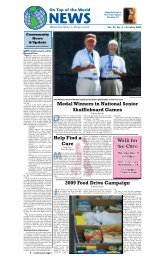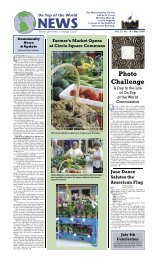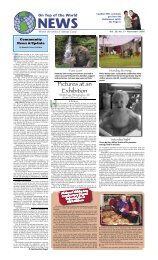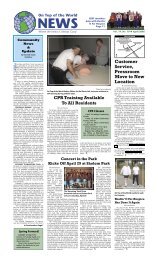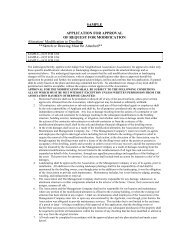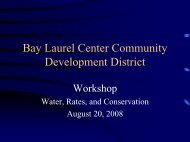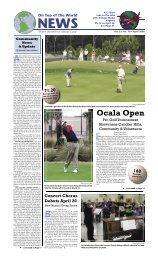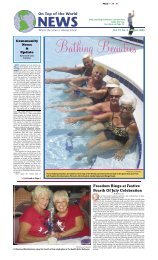Aeration and Topdressing for the 21st Century - USGA Green ...
Aeration and Topdressing for the 21st Century - USGA Green ...
Aeration and Topdressing for the 21st Century - USGA Green ...
- No tags were found...
You also want an ePaper? Increase the reach of your titles
YUMPU automatically turns print PDFs into web optimized ePapers that Google loves.
BY PAT O'BRIEN <strong>and</strong> CHRIS HARrWlGER~i;F 7:. #'Putting green aeration <strong>and</strong> topdressing areliterally <strong>and</strong> figuratively dirty words. Golfersbegrudgingly accept <strong>the</strong> fact that to protect<strong>the</strong> long-term health of <strong>the</strong> grass on a puttinggreen, it is necessary to aerate <strong>and</strong> top dress eachyear. With more sophisticated products <strong>and</strong> techniques,gone are <strong>the</strong> days when putting greenswere aerated in <strong>the</strong> spring <strong>and</strong> fall <strong>and</strong> buried in ablanket of s<strong>and</strong>. But lost in <strong>the</strong> changes to <strong>the</strong>seprograms may be an incomplete underst<strong>and</strong>ing ofhow much aeration <strong>and</strong> topdressing are needed toprotect <strong>the</strong> long-term health of <strong>the</strong> greens.The long-term health of putting greensdepends on maintaining s<strong>and</strong> as <strong>the</strong> primarymedium. If organic matter accumulates beyond areasonable degree, <strong>the</strong> physical benefits of s<strong>and</strong> arediminished <strong>and</strong> putting green physical propertiesdecline along with <strong>the</strong> health of <strong>the</strong> turf. For toolong golf courses have been making changes in<strong>the</strong>ir aeration <strong>and</strong> topdressing programs withoutcomparing <strong>the</strong>se changes to a st<strong>and</strong>ard or targetlevel. A previous <strong>Green</strong> Section Record article titled"Core <strong>Aeration</strong> by <strong>the</strong> Numbers" detailed howtine size <strong>and</strong> spacing affects <strong>the</strong> amount of surfacearea impacted by an aeration treatment <strong>and</strong> madea recommendation to impact 15-20% of <strong>the</strong>surface each year (O'Brien <strong>and</strong> Hartwiger, 2001).This recommendation did not go far enoughbecause it did not include surface topdressingapplications, which go h<strong>and</strong> in h<strong>and</strong> with coreaeration in diluting organic matter accumulation.This article exp<strong>and</strong>s upon <strong>the</strong>se concepts <strong>and</strong>links core aeration <strong>and</strong> s<strong>and</strong> topdressing.THE SIGNIFICANCE OF COREAERATION AND SAND TOPDRESSINGAccording to University of Georgia turfgrassresearcher Dr. Bob Carrow, <strong>the</strong> number-oneproblem experienced on s<strong>and</strong>-based puttinggreens is <strong>the</strong> excessive accumulation of organic, ~_:t~.- ..,"... _~_'""""'iT __ "._'r_",,"-_ -::'---.-. _ -'_. -'_.. _-Using dry s<strong>and</strong><strong>and</strong> <strong>the</strong> propertopdressingequipmentworkerimprovesproductivity<strong>and</strong> helps reducegolfercomplaints.MARCH-APRIL 2003
matter in <strong>the</strong> upper portion of <strong>the</strong> soil profIle(Carrow et al., 2002). Core aeration <strong>and</strong> s<strong>and</strong>topdressing are <strong>the</strong> two most effective means tocontrol <strong>the</strong> content <strong>and</strong> distribution of organicmatter in this zone. The scientifIc literature is fullof references to <strong>the</strong> benefIts of core aeration <strong>and</strong>s<strong>and</strong> topdressing. Un<strong>for</strong>tunately, details on howmuch aeration <strong>and</strong> topdressing are needed arelacking.The moment any type of grass is planted ona putting green rootzone mix, <strong>the</strong> soil physicalproperties in <strong>the</strong> upperfew inches of <strong>the</strong> rootzonebegin to change(Habeck <strong>and</strong> Christians,2000; Curtis, 2001).In a new putting green<strong>the</strong> cycle of rootgrowth, decline, <strong>and</strong>new growth is repeatedyear after year. Rootsgrow down through<strong>the</strong> soil in <strong>the</strong> large soilpores (macropores) <strong>and</strong> provide <strong>the</strong> plant withneeded water, oxygen, <strong>and</strong> nutrients. When aroot is no longer viable, it begins to plug up soilmacropores <strong>and</strong> can hinder <strong>the</strong> ability of livingplants to function.Dr. Carrow conducted extensive research(Carrow, 1998) in <strong>the</strong> mid-1990s on <strong>the</strong> organicmatter dynamics in <strong>the</strong> rootzone of s<strong>and</strong>-basedputting greens. He concluded as organic matter ina s<strong>and</strong>-based putting green reaches 3-4% byweight, <strong>the</strong> percentage of soil macropores beginsto decrease. The reduction of pore space has threedistinct implications, <strong>and</strong> a host of primary problemscan be expected: 1) The diffUsion of oxygeninto <strong>the</strong> rootzone begins to decline. Oxygen isvital <strong>for</strong> plant growth as well as soil microorganismbalance <strong>and</strong> function. 2) Water infiltration decreases,which can result in puddling <strong>and</strong> saturationof <strong>the</strong> surface. 3) Moisture content in <strong>the</strong>upper rootzone increases, which can make <strong>the</strong>surface less fIrm. The decrease in macropores(aeration pores) is accompanied by an increase incapillary or water-holding pores.If organic matter accumulation begins toexceed 3-4% by weight, putting greens becomevulnerable to a host of secondary problems suchas disease, wet wilt, soft surfaces, poor root growth,black layer, <strong>and</strong> more frequent high-temperatureinjury. These secondary problems are often calledsummer bentgrass decline (Carrow et al., 2002),<strong>and</strong> trYing to treat <strong>the</strong>m curatively can be expensive.Theyoccur often at courses that have notadequately aerated <strong>and</strong> topdressed <strong>the</strong> greens.Many of <strong>the</strong>se courses are doomed to many yearsof frustration because <strong>the</strong>y are not willing tomake <strong>the</strong> ef<strong>for</strong>t to do <strong>the</strong> additional aeration <strong>and</strong>topdressing needed to prevent <strong>the</strong> situation.Dr. Carrow's research shows that core aeration<strong>and</strong> applYing s<strong>and</strong> can help dilute organic accumulation<strong>and</strong> create new macropores. The remainderof this article will be devoted to developing anaeration <strong>and</strong> topdressing program that keepsorganic matter levels below 3-4% by weight. Thisproactive approach ultimately will cause less disruption<strong>and</strong> be less expensive than trYing toalleviate primary <strong>and</strong> secondary problems througha curative approach.The organic matter dilution program is a catch-allterm that includes core aeration accompanied bys<strong>and</strong> topdressing to fill <strong>the</strong> holes <strong>and</strong> s<strong>and</strong> topdressingapplied directly to <strong>the</strong> surface. Referencesto core aeration refer only to hollow-tine aerationat a st<strong>and</strong>ard depth of 3 inches. <strong>Aeration</strong> depthcan vary signifIcantly based upon machine <strong>and</strong>type of tine used. Deep-tine aeration or similarpractices designed to correct deep rootzone issuesare not considered. Suiface topdressing refers to s<strong>and</strong>applied directly to <strong>the</strong> turf grass canopy. Light,medium, <strong>and</strong> heavy topdressing applications areapproximately 0.50 ft: per 1,000 ft?, 2.0 ft: per1,000 fe, <strong>and</strong> 4.0 fe per 1,000 ft?, respectively.AERATION AND TOPDRESSINGRECOMMENDATIONSThe case has been made <strong>for</strong> <strong>the</strong> importance ofusing core aeration <strong>and</strong> s<strong>and</strong> topdressing to dilute<strong>the</strong> accumulation of organic matter. The questionis, How much of each needs to be done? We proposeanswering this question in a slightly differentway. The answer requires linking <strong>the</strong> topics ofaeration <strong>and</strong> topdressing toge<strong>the</strong>r. We link <strong>the</strong>two toge<strong>the</strong>r because <strong>the</strong>y are <strong>the</strong> key elements inan organic matter dilution program. Core aerationremoves organic matter. Filling <strong>the</strong> holes withs<strong>and</strong> makes sure those columns stay open. Dustingsof s<strong>and</strong> applied directly to <strong>the</strong> surface alsohelp manage organic matter accumulation.ApplYing at least 40-50 ft: of s<strong>and</strong> per 1,000 ft?per year is recommended to keep organic mattercontent below 3-4% by weight in <strong>the</strong> upperportion of <strong>the</strong> rootzone. Although this recommendationis brief, underst<strong>and</strong>ing all its ramifIcationsis more complex, <strong>and</strong> it should stimulate2 GREEN SECTION RECORD
many questions that will be addressed in <strong>the</strong>following sections.UNDERSTANDING SAND VOLUMESRates of s<strong>and</strong> topdressing can be difficult toconceptualize. Table 1 shows quantities of s<strong>and</strong>expressed in different units <strong>and</strong> yields someinteresting comparisons. Conveniently, it turnsout that 100 pounds of dry s<strong>and</strong> is equivalent to1.0 ft~ of s<strong>and</strong>. Wet s<strong>and</strong> is approximately 6-10%heavier <strong>for</strong> an equivalent volume. Finally, <strong>the</strong> s<strong>and</strong>quantities are expressed in inches, which are easierto conceptualize <strong>for</strong> large quantities of s<strong>and</strong>.TO CORE OR NOT TO CORE,THAT IS NOTTHE QUESTIONBy now, many readers will have looked at <strong>the</strong>recommendation <strong>and</strong> said, "Aha. If we apply 40-50 ft~ of s<strong>and</strong> per 1,000 ft; through regular topdressingapplications, we will not need to coreaerate <strong>the</strong> greens." It is easy to see how this interpretationcould be made, but this strategy is notrecommended. There are agronomic <strong>and</strong> practicalreasons <strong>for</strong> not trYing this approach. Therearemerits to removing organic matter through coreaeration <strong>and</strong> packing <strong>the</strong>se vertical columns thatcut through <strong>the</strong> high organic matter zone withs<strong>and</strong>. Applying 50 ft~ of s<strong>and</strong> per 1,000 ft?through surface topdressing would only requireapproximately 25 applications of2.0 ft~ per 1,000ft;, or one application every two weeks. Thiswould be far too stressful during <strong>the</strong> summer<strong>and</strong> would be difficult to work into <strong>the</strong> canopyduring periods of slow winter growth. Invariably,interference with play <strong>and</strong> wea<strong>the</strong>r make thisprogram impractical.Similarly, do not try to meet <strong>the</strong> topdressingrequirement with only core aeration <strong>and</strong> filling<strong>the</strong> holes with s<strong>and</strong>. This method could result inlayering. All applied s<strong>and</strong> is not worked into <strong>the</strong>holes; some falls between <strong>the</strong> holes. This excesss<strong>and</strong> wouldonly be mixed into <strong>the</strong> canopy twiceper year if <strong>the</strong> greens are aerated twice per year.Additionally, it would be difficult to keep s<strong>and</strong> as<strong>the</strong> primary component of <strong>the</strong> rootzone matrixnear <strong>the</strong> surface without regular surfacetopdressing applications.<strong>the</strong> aeration holes. Based upon field observations,<strong>the</strong> smallest hole that can be reliably filled withs<strong>and</strong> is created by a tine of just less than Yz in.Holes of % in. diameter are not easily filled, evenwith <strong>the</strong> driest s<strong>and</strong>. Outlined below are a fewsample programs to stimulate thought. There is nosingle program that is right <strong>for</strong> everybody, butwith an overall goal of total topdressing applied, aplan that meets <strong>the</strong> needs of any course can bedeveloped.• Program 1:Big Holes, Big Spacing. Thisapproach uses traditional aeration equipment with% in. tines on a 2 in. X 2 in. spacing. The greensare aerated once in <strong>the</strong> spring <strong>and</strong> once in <strong>the</strong>fall. A total of 36 ft: per 1,000 ft? (3,600 lbs. per1,000 ft?) is applied <strong>for</strong> <strong>the</strong> two core aerations.See Table 2 to see s<strong>and</strong> volumes required to fillaeration holes <strong>for</strong> o<strong>the</strong>r tine sizes <strong>and</strong> spacingpatterns.The remaining 14 ft~ of s<strong>and</strong> necessary per1,000 ft? to meet <strong>the</strong> 50 fe goal is applied vialight to moderate topdressings throughout <strong>the</strong>year. A light to moderate topdressing is consideredto be anywhere from 0.5 ft~to 2.0 ft: per 1,000ft? This is rougWy equivalent to 50 to 200 lbs. ofs<strong>and</strong> per 1,000 ft;• Program 2: Dethatching. This program is<strong>for</strong> new construction only or <strong>for</strong> a putting greenthat has met <strong>the</strong> topdressing requirement. Adethatching machine is used to physically removeorganic matter from <strong>the</strong> upper portionof <strong>the</strong>SAMPLE PROGRAMSThe best program is one that includes a certainamount of core aeration along with regular s<strong>and</strong>topdressings. When considering tine sizes, select asize that allows easy <strong>and</strong> complete backfilling ofMARCH-APRIL 2003 3
Seeing is believing withvolumetricmeasurements.Light, medium,<strong>and</strong> heavy surfacetopdressingratesare approximately0.50 ft! per 1,000 ft?-,2.0 ft! per 1,000 ft?-, <strong>and</strong>4.0 ft! per 1,000 ft?-,respectively.profile. Spring <strong>and</strong> fall dethatching treatments areper<strong>for</strong>med. Less disruption to play is <strong>the</strong> primaryadvantage. This program is not recommended as acurative approach on greens with excessiveorganic matter. It is too difficult to incorporates<strong>and</strong> into <strong>the</strong> channels made by <strong>the</strong> dethatchingequipment, especially when <strong>the</strong> grooves are cutgreater than 0.25 in. deep.The amount of s<strong>and</strong> incorporated into <strong>the</strong>canopy following dethatching is much lower thanwith core aeration. As channel depth increases,s<strong>and</strong> incorporation decreases because <strong>the</strong> channelscollapse <strong>and</strong> seal off. This may be considered adisadvantage because much more time must bespent applying light <strong>and</strong> moderate topdressingsthroughout <strong>the</strong> year. For example, assume<strong>the</strong> greens are dethatched with %4 in. blades.Approximately 14% of <strong>the</strong> surface area isimpacted, but only 1-3 ft? per 1,000 fe of s<strong>and</strong>is applied. This amount is highly variable <strong>and</strong>depends on how well <strong>the</strong> dethatching channelsstay open. This leaves 40-44 ft? per 1,000 fe leftto be applied throughtopdressings .light <strong>and</strong> moderateMany courses that use a dethatching machineuse it in combination with an aerator. Somedethatch <strong>and</strong> aerate at <strong>the</strong> same time, while o<strong>the</strong>rsde thatch <strong>and</strong> aerate on separate dates.The moderate topdressings (2.0 ft? per 1,000ft?) should be applied at a time of year whenorganic accumulation is most rapid. On bentgrassputting greens in <strong>the</strong> South, <strong>the</strong> period ofOctober through April is <strong>the</strong> most prolific periodof organic matter production. Bermudagrassgreens generate <strong>the</strong> most organic matter in <strong>the</strong>summer months. Light topdressings can beapplied at any time of <strong>the</strong> year.• Small Holes, Small Spacing. A sampleprogram using this approach might include <strong>the</strong>following: super quad tines with an outside tinediameter of 0.420 on a 1 in. X 1Ysin. spacing. Thegreens are aerated twice in <strong>the</strong> spring <strong>and</strong> once ortwice in <strong>the</strong> fall. The total amount of s<strong>and</strong>required to fill <strong>the</strong> holes after each aeration isapproximately 6.15 ft? per 1,000 fe or 18-24 ft?per 1,000 fe per year. The remaining16-32 ft?per 1,000 fe can be applied through light ormoderate topdressings throughout <strong>the</strong> year.This approach relies on smaller tine diameters<strong>and</strong> a tighter spacing pattern. The advantage ofthis program is reduced healing time becausesmaller diameter holes require less time to healthan larger holes. The disadvantages are <strong>the</strong> need<strong>for</strong> special equipment <strong>and</strong> more difficulty filling<strong>the</strong> aeration holes. As hole size decreases, <strong>the</strong> likelihoodof s<strong>and</strong> particles bridging over <strong>the</strong> surfaceof <strong>the</strong> hole increases. The super quad tine onlygoes 1.75 in. into <strong>the</strong> rootzone, which could be aconcern with a thick layer of organic accumulation.An aerator with variable spacing <strong>and</strong> a tractorwith a creeper gear are necessary to duplicate thisprogram. For best results, take <strong>the</strong> time to makesure <strong>the</strong> holes are open <strong>and</strong> clean, <strong>and</strong> try to use<strong>the</strong> driest s<strong>and</strong> possible.4 GREEN SECTION RECORD
THEORYVS. REALITY:CALCULATING SAND VOLUMEEvery golf course is faced with a unique set ofcircumstances. Determining <strong>the</strong> total amount oftopdressing applied can be challenging. Table 2shows <strong>the</strong> approximate amount of s<strong>and</strong> necessaryto fill aeration holes with s<strong>and</strong> <strong>for</strong> common tinesizes <strong>and</strong> spacing.When recommended topdressing amounts arein h<strong>and</strong>, <strong>the</strong> turf grass manager must adjust <strong>the</strong>topdressing applied if it is determined that <strong>the</strong>s<strong>and</strong> is not working easily into <strong>the</strong> holes. Sometimes<strong>the</strong> greens are damp or <strong>the</strong> s<strong>and</strong> is wet. Thedegree to whichs<strong>and</strong> is filled into <strong>the</strong> holes canvary, too. The key point is not whe<strong>the</strong>r <strong>the</strong> suggestedamount is applied to fill <strong>the</strong> holes, but howmuch s<strong>and</strong> actually is applied. This in<strong>for</strong>mation ishelpful when calculating yearly volume <strong>and</strong> determininghow much s<strong>and</strong> must be added throughlight or moderate topdressing applications.When calculating s<strong>and</strong> volume applied, ano<strong>the</strong>rconsideration is estimating how much s<strong>and</strong> isthrown onto areas o<strong>the</strong>r than <strong>the</strong> putting green.This is an issue when spinner top dressers are usedto apply light or moderatetopdressings.MEETING THE RECOMMENDATION:IS MORE OR LESSNEEDED?The beauty of coupling aeration <strong>and</strong> topdressingtoge<strong>the</strong>r <strong>and</strong> making an annual topdressingrecommendation as a target value is its simplicity<strong>and</strong> flexibility. It may need to be adjusted upwardor downward, depending on individual circumstances.The Atlanta, Georgia, climate was selected<strong>for</strong> this recommendation. O<strong>the</strong>r areas may requirea higher topdressing or lower requirement basedupon some of <strong>the</strong> factors listed below.• Nitrogen Levels. Nitrogen is directly relatedto organic matter production. Higher nitrogenprograms may be required on putting greens wi<strong>the</strong>xtremely high traffic levels or on greens thatmust be grownin from some type of seasonaldamage. More topdressing may be required.<strong>Green</strong>s managed under low nitrogen programsmay require somewhat less s<strong>and</strong> .• Soil pH. A soil pH > 5.5 is optimal <strong>for</strong>bacterial activity <strong>and</strong> organic matter decomposition.Soil pH much below this level reducesorganic matter decomposition, <strong>and</strong> more topdressingmay be required.• Turfgrass Species. The 40-50 ft? per 1,000fe recommendation is <strong>the</strong> minimum requirement<strong>for</strong> many bentgrass <strong>and</strong>/or Paa annua puttinggreens <strong>and</strong> may need to be adjusted annually.N on-overseeded Tifdwarf or Tifgreen bermudagrassputting greens will have a slightly lowerannual topdressing requirement, somewhere in<strong>the</strong> range of35-40 ft? per 1,000 ft? Non-overseededultradwarfgreens may require 40-50 ft?per 1,000 ft? Overseeded Tifdwarf or Tifgreenbermudagrass putting greens will require 40-50ft? per 1,000 ft?, but with newer ultradwarfcultivars that tend to accumulate organic matterin <strong>the</strong> surface 1-2 in., a somewhat higher amountmay be necessary. For newer bermudagrass cultivars,<strong>the</strong> "small holes, small spacing" programapplied at more than two times per year is a goodoption. High annual topdressing s<strong>and</strong> rates areimportant <strong>for</strong> <strong>the</strong> newer bentgrass cultivars thattend to accumulate organic matter in <strong>the</strong> surfaceor in climates where organic matter accumulationis favored. In <strong>the</strong>se situations, <strong>the</strong> "small holes,small spacing" program is worth trying.UNUSUAL FIELD CONDITIONSTwo common field conditions exist that mayrequire a higher s<strong>and</strong> requirement or an adjustmentas to when s<strong>and</strong> should be applied.• Rapid Root Dieback. This condition ischaracterized by <strong>the</strong> rapid death of a bentgrassroot system caused by high temperatures in <strong>the</strong>summer months. When bentgrass roots die backsuddenly, <strong>the</strong> nature of some of <strong>the</strong> organic matterOrganic matteraccumulation in <strong>the</strong>upper rootzone is <strong>the</strong>primary reason whyputting greens sometimesfail over time.Proper aeration <strong>and</strong>topdressing programscan prevent excessorganic matteraccumulation.MARCH-APRIL 2003 5
Rapid root dieback onbentgrass putting greensin <strong>the</strong> summer producesa gel-like layer in <strong>the</strong>upper rootzone <strong>and</strong> lowsoil oxygen levels. Turfloss can occur within 24to 72 hours, <strong>and</strong> extraaeration (!.nd topdressingwill be needed topromote recovery.changes from live root structuresto decomposingorganic matter with a gel-like consistency. Dr.Carrow states, "It is not <strong>the</strong> lack of roots fromroot dieback that is <strong>the</strong> problem, but <strong>the</strong> creationof an excessively moist layer from <strong>the</strong> decomposingroot tissues with very low oxygen during hotwea<strong>the</strong>r in response to <strong>the</strong> rapid root dieback"(Carrow et al., 2002). The remaining roots areunder low oxygen stress <strong>and</strong> cannot take upenough water <strong>for</strong> transpirational cooling. Reducedwater uptake, stomatal closure, <strong>and</strong> high-temperaturekill can follow. Field symptoms are a yellowingof <strong>the</strong> turf <strong>and</strong> death over a one- to three-dayperiod of hot, humid wea<strong>the</strong>r. This scenario canoccur at organic matter levels of 3-5% by weightin <strong>the</strong> top 1 in. of <strong>the</strong> rootzone, but it is muchmore likely when organic matter is greater than5% by weight (Carrow et al., 2002). Mter <strong>the</strong>hot wea<strong>the</strong>r has ended, it will be necessary tocontinue diluting this rapid accumulation o<strong>for</strong>ganic matter created from <strong>the</strong> dead roots as wellas organic matter arising from new root initiation.The topdressing requirement will increase <strong>and</strong>should be met through a combination of surfacetopdressing <strong>and</strong> filling aeration holes.• Cool-Wea<strong>the</strong>r Organic Accumulation.Root growth can be rapid during periods of coolwea<strong>the</strong>r. Roots grow down through <strong>the</strong> macroporechannels <strong>and</strong> adventitious roots grow near<strong>the</strong> surface. Although live organic matter does notreduce oxygen availability as severely as decomposingorganic matter, oxygen infIltration <strong>and</strong>water infiltration can decrease as <strong>the</strong> roots fillmany of <strong>the</strong> macropores. This is commonlyobserved in <strong>the</strong> winter to early spring monthswhen greens begin to puddle more substantiallyafter a rain. The problem is more severe in coolerclimates with prolonged soil temperatures above32°F, but less than 55°F. Bentgrass/ Paa annuawill grow in temperatures above 32°F, but soilmicrobes necessary <strong>for</strong> organic matter decompositiondo not function below 55°F. These conditionsare more common in nor<strong>the</strong>rn climates<strong>and</strong>, particularly, coastal nor<strong>the</strong>astern <strong>and</strong> coastalnorthwestern climates. O<strong>the</strong>r than a reductionin water infiltration, surface symptoms are notobserved, but suboptimal oxygen levels can reduce<strong>the</strong> rate of deeper rooting. Mter spring aeration,adequate oxygen will be available <strong>for</strong> maximumroot growth.PROGRESS REPORTTurf managers who have embarked on an organicmatter dilution program will be curious abouthow <strong>the</strong> program is working. There are threeways to assess <strong>the</strong> program's effectiveness.The fIrst is to send a core sample of <strong>the</strong> top1-2 in. of <strong>the</strong> rootzone profile to a physical soiltesting laboratory. Request a test to determineorganic matter by weight.6 GREEN SECTION RECORD



